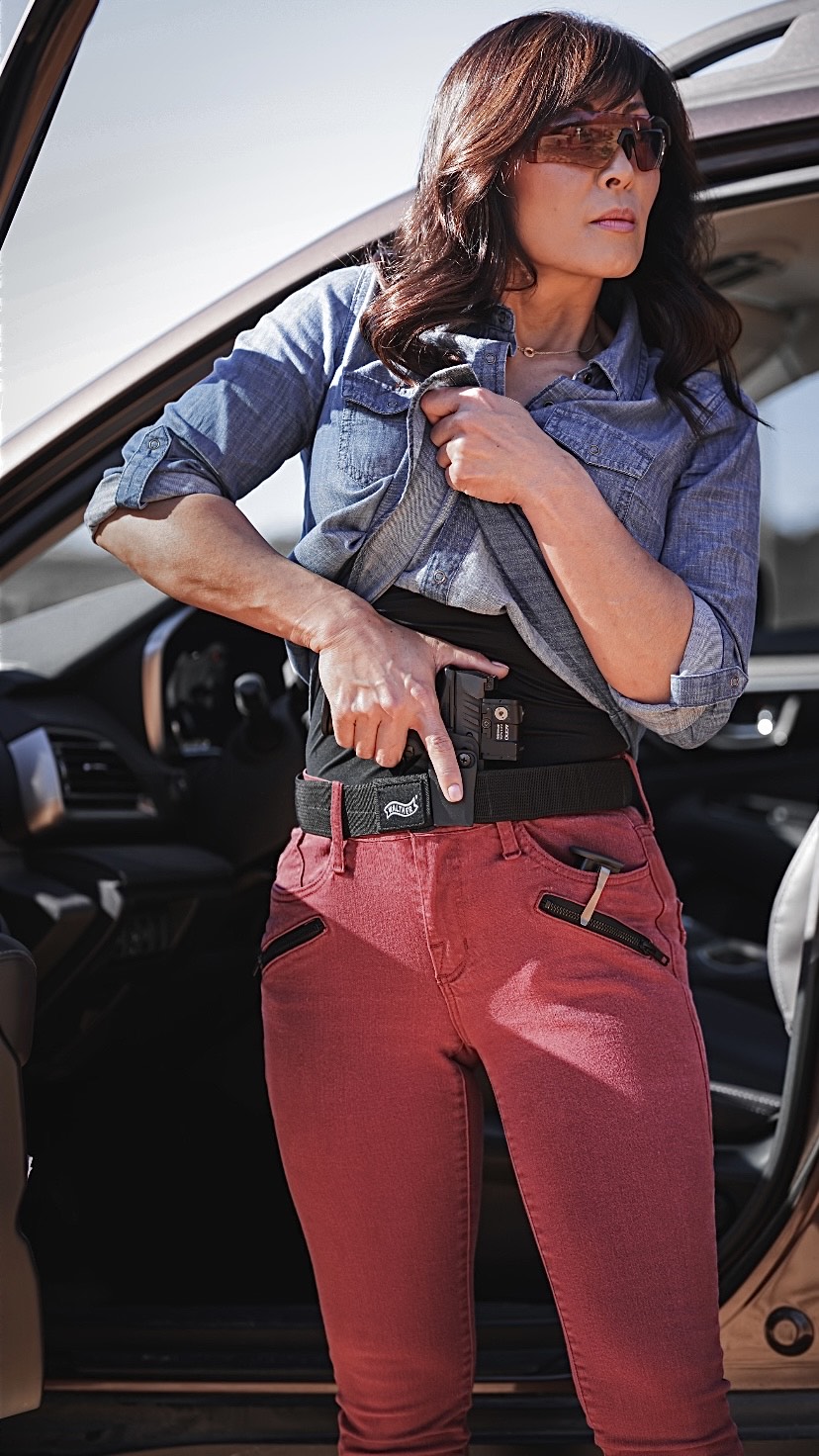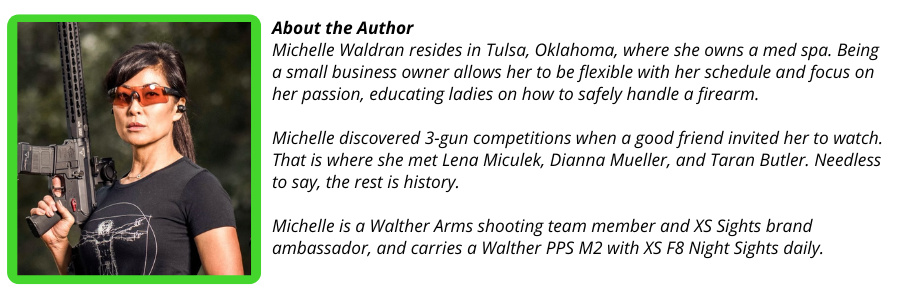Concealed Carry for Women - a Complete Guide
Posted by Michelle Waldran on Apr 11th 2024
POV from a female. What to consider when you decide to conceal and carry for protection.
As a woman who carries a firearm for concealed carry, there are several important considerations to keep in mind to ensure safety, comfort, and effectiveness. Here are some key factors for women to consider when carrying a concealed firearm on the body:
**Appropriate Firearm Selection. Size does matter!**
Choose a firearm that you can comfortably handle and shoot effectively. Consider factors such as size, weight, grip size, and recoil when selecting a firearm for concealed carry. Budget is important as well, especially if you can only afford one. When you're on a budget, you don't want to under or over buying your first firearm. Rentals are available to test different options at your local shooting range to find the right fit for your needs. If rentals are limited, ask a friend who owns a firearm. Most likely, they will have other friends who own firearms as well.
**Holster Selection**
Choose a holster specifically designed for women's concealment that provides a secure and comfortable fit. Consider factors like concealability, comfort, retention, accessibility, and safety features when selecting a holster for your firearm. You may opt for a couple of options. One for work (if allowed) and during casual/formal events. An unconventional holster system may not be suitable for beginners. Use your judgment and consider your skill level when searching for the perfect holster. You should feel confident in your choice when carrying on your body.
**Clothing Choices**
Dress in a way that accommodates your concealed carry setup. This doesn't mean you need to change your style. You may consider upsizing that cute top when shopping to accommodate better concealment. Choose clothing styles that allow easy access to your firearm while maintaining concealment. Consider patterns or strategic stitching in the fabric to help conceal the outline of the firearm.
**Training and Practice**
Regular training and practice are essential for safe and effective concealed carry. Take courses on firearms safety, marksmanship, and self-defense techniques to improve your skills. Practice drawing unloaded and firing your firearm from your chosen holster (check with your range; some may not allow you to draw from your holster) to build proficiency.
**Awareness and Situational Awareness**
Stay alert and aware of your surroundings at all times. Practice situational awareness to identify potential threats and escape routes in different environments. Women should strive to avoid potentially dangerous situations whenever possible. For example, it's 10 p.m., and you're out of coffee for the morning. It can wait; just swing by your favorite coffee shop on the way to work. Trust your instincts and be prepared to act defensively if needed.
**Legal Knowledge**
In my opinion, familiarizing yourself with the laws and regulations governing concealed carry in your state or region is the most important step you take as a responsible gun owner and daily carrier. Understand where you can legally carry your firearm, how to interact with law enforcement if approached, and the legal use of deadly force in self-defense situations.
**Maintenance and Care**
Regularly maintain and clean your firearm to ensure its proper function. Check your firearm, holster, and ammunition for wear and tear, and replace any components that show signs of damage. Proper maintenance is crucial for reliable performance in critical situations. When spring cleaning or sprucing up the garden each year, it is also a great reminder to maintain your firearm and equipment. This step also helps you gain confidence and understand how the firearm functions.
**Mindset and Responsiveness**
Develop a confident and responsible mindset towards concealed carry. Be prepared mentally and emotionally to defend yourself if necessary. Stay calm under pressure and practice de-escalation techniques to avoid confrontations whenever possible. By considering these factors when you conceal and carry, women can effectively and responsibly carry a firearm for self-defense while prioritizing safety, training, and adherence to legal requirements.
Finding the perfect holster for women's concealment.
When looking for the perfect holster for women's concealment, several factors must be considered to ensure comfort, security, and ease of access. Here are some key points to keep in mind when choosing a holster:
**Fit and Comfort**
The holster should be specifically designed for women, taking into account body shape and clothing styles. Look for holsters that offer adjustability in cant (angle) and ride height to ensure a comfortable fit for your body type.
**Concealability**
Choose a holster that allows for effective concealment of your firearm under various types of clothing. Options like belly bands, bra holsters, or ankle holsters may provide better concealment for some women's clothing styles compared to traditional hip holsters. Remember that unconventional systems may not be the right fit for a beginner. Trust your judgment and your level of skill set.
**Retention**
It is crucial that the holster securely retains your firearm to prevent accidental exposure or loss. Look for holsters with adjustable retention mechanisms or trigger guards to keep your firearm in place. Most Kydex holsters will have adjustable screws to customize the retention. Having too much retention can slow the draw and waste too much time.
**Accessibility**
The holster should allow quick and easy access to your firearm when needed. Consider the draw angle and positioning of the holster to ensure that you can quickly deploy your weapon in a self-defense situation. Also, consider clothing clearance. Find the right outfit for quick access.
**Material and Construction**
Choose a holster made from high-quality materials such as Kydex, leather, or nylon that is durable and provides sufficient protection for your firearm. The holster should be resistant to moisture and wear to ensure longevity.
**Conceal Carry Method**
Select a carry style that fits your preferences and lifestyle, whether inside-the-waistband (IWB), outside-the-waistband (OWB), ankle carry, or shoulder carry… oh my! We have so many options these days that it could be overwhelming. Each method has pros and cons, so choose one that aligns with your comfort and daily activities.
**Safety**
Prioritize holsters that cover the trigger guard completely to prevent accidental discharges. Safety should always be a top consideration when selecting a holster for concealed carry.
**Reviews and Recommendations**
Research different holster options and read reviews from other female concealed carry owners. Seek recommendations from trusted sources, firearms instructors, or a close friend to find a holster that meets your needs and preferences. Try out different holster options. Most manufacturers offer a "try it" period and other return policies. You can find the perfect holster for women's concealment, offering comfort, security, and practicality for your concealed carry needs.
⠀⠀⠀⠀⠀⠀⠀⠀⠀⠀⠀⠀⠀⠀⠀
Challenges of Concealed Carry for Women
Concealed carry, the practice of carrying a concealed weapon for self-defense, is a topic that has gained considerable attention in recent years as personal safety concerns have heightened. While both men and women engage in concealed carry practices, there are specific challenges that women face when attempting to conceal and carry a firearm.
Firstly, one of the primary reasons why it is difficult for women to conceal and carry is related to clothing choices. Women's fashion tends to be more form-fitting compared to men's clothing, making it harder to effectively conceal a firearm without it printing or becoming noticeable. Most holsters and concealment options are designed with male body shapes in mind, which can make finding comfortable and effective concealment options a challenging task for many women. Additionally, many women prefer to carry their firearms in purses or bags for convenience. Still, this method can also present safety concerns and delays in accessing the firearm in an emergency.
Secondly, anatomical differences between men and women also play a significant role in the challenges women face with concealed carry. Women typically have smaller hands and frames, which can make it difficult to find a firearm that fits comfortably and can be easily manipulated. The size and weight of the firearm, as well as the strength required to operate it, can present obstacles for many women.
Additionally, the location of carry can be a concern, as women often have different body shapes and clothing styles that affect where and how they can effectively conceal a firearm.
Furthermore, societal stereotypes and biases can make it challenging for women to engage in concealed carry practices. There is often a misconception that women are not as capable or knowledgeable about firearms as men, leading to potential judgment or skepticism from others when a woman chooses to carry a concealed weapon. This can create added pressure and obstacles for women who are already navigating the complexities of concealed carry.
In conclusion, the challenges of concealing and carrying as a female stem from a combination of factors, including clothing choices, anatomical differences, and societal perceptions. To address these obstacles, it is essential to promote inclusivity in the design of concealment options, provide adequate training and resources tailored to women, and challenge gender stereotypes within the firearms community.
Companies are now recognizing and addressing these challenges. We all can work towards creating a more supportive and empowering environment for women who choose to engage in concealed carry practices.




